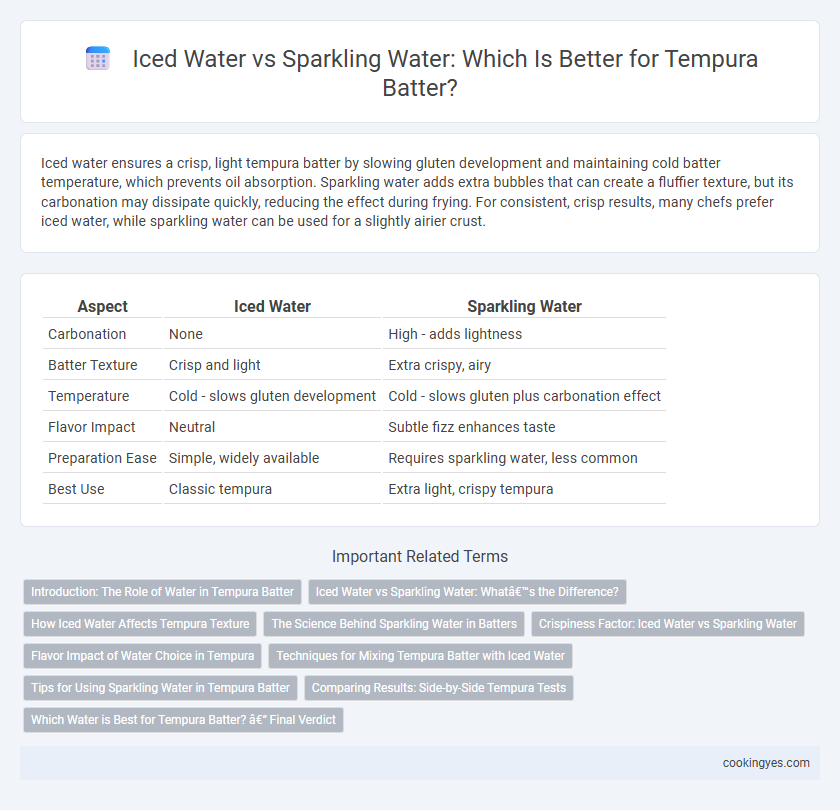Iced water ensures a crisp, light tempura batter by slowing gluten development and maintaining cold batter temperature, which prevents oil absorption. Sparkling water adds extra bubbles that can create a fluffier texture, but its carbonation may dissipate quickly, reducing the effect during frying. For consistent, crisp results, many chefs prefer iced water, while sparkling water can be used for a slightly airier crust.
Table of Comparison
| Aspect | Iced Water | Sparkling Water |
|---|---|---|
| Carbonation | None | High - adds lightness |
| Batter Texture | Crisp and light | Extra crispy, airy |
| Temperature | Cold - slows gluten development | Cold - slows gluten plus carbonation effect |
| Flavor Impact | Neutral | Subtle fizz enhances taste |
| Preparation Ease | Simple, widely available | Requires sparkling water, less common |
| Best Use | Classic tempura | Extra light, crispy tempura |
Introduction: The Role of Water in Tempura Batter
Water temperature and type significantly affect tempura batter texture and crispiness. Iced water slows gluten development, resulting in a lighter, crunchier coating, while sparkling water introduces carbonation that creates extra bubbles, enhancing batter aeration and crispness. Using cold, carbonated water is a preferred technique to achieve the signature delicate, flaky tempura crust.
Iced Water vs Sparkling Water: What’s the Difference?
Iced water is preferred for tempura batter because its cold temperature slows gluten formation, resulting in a lighter, crispier texture. Sparkling water introduces carbon dioxide bubbles that can create a slightly airier batter, but excessive carbonation may cause uneven frying and a less delicate crust. Choosing between iced and sparkling water depends on achieving the ideal balance of temperature and texture for optimal tempura crispness.
How Iced Water Affects Tempura Texture
Iced water in tempura batter helps maintain a low temperature that prevents gluten development, resulting in a lighter and crispier texture. The cold temperature slows down the mixing process, reducing batter absorption and creating a delicate, airy crust. Sparkling water, while adding bubbles for crispiness, heats up faster during mixing, which can slightly compromise the tempura's lightness compared to iced water.
The Science Behind Sparkling Water in Batters
Sparkling water contains dissolved carbon dioxide that creates tiny bubbles, which contribute to a lighter and crispier tempura batter by aerating the mixture and reducing gluten formation. The effervescence helps trap air pockets during frying, enhancing texture and preventing the batter from becoming dense or greasy. Compared to iced water, sparkling water improves the batter's crispness and crunch due to its carbonation and slightly alkaline pH, which react with flour proteins for optimal results.
Crispiness Factor: Iced Water vs Sparkling Water
Iced water maintains a consistent cold temperature in tempura batter, slowing gluten development and resulting in a crispier texture. Sparkling water introduces carbonation that can lighten the batter but may cause uneven bubbles, potentially compromising uniform crispiness. For optimal tempura crispiness, iced water is often preferred due to its stabilizing effect on batter temperature and texture.
Flavor Impact of Water Choice in Tempura
Using iced water in tempura batter enhances crispiness by slowing gluten development, resulting in a light texture that highlights the fresh flavors of seafood and vegetables. Sparkling water introduces carbonation that creates a delicate crunch; however, its mineral content can sometimes alter the subtle umami and sweetness of the tempura ingredients. Chefs often prefer iced water to maintain a pure, clean flavor profile while achieving optimal batter texture.
Techniques for Mixing Tempura Batter with Iced Water
Using iced water in tempura batter maintains a low temperature that prevents gluten development, resulting in a light, crispy texture. The cold temperature slows the mixing process, allowing the batter to remain slightly lumpy, which creates a delicate, airy coating during frying. Sparkling water introduces bubbles that can make the batter fluffier, but iced water's consistent coldness is more effective for achieving the traditional crispiness and minimizing oil absorption.
Tips for Using Sparkling Water in Tempura Batter
Using sparkling water in tempura batter enhances crispiness by introducing fine bubbles that create a lighter texture when fried. For optimal results, keep the sparkling water chilled and mix gently to retain carbonation, preventing the batter from becoming dense. Avoid overmixing to maintain batter aeration and achieve the signature delicate, airy tempura crust.
Comparing Results: Side-by-Side Tempura Tests
Iced water creates a lighter, crispier tempura batter by slowing gluten development and maintaining low batter temperature, resulting in a delicate texture with minimal oil absorption. Sparkling water introduces carbonation that can enhance crispiness and add slight puffiness, but its higher mineral content sometimes makes the batter heavier and less uniform compared to iced water. Side-by-side tests consistently show iced water produces a more tender, evenly fried tempura, while sparkling water offers a distinct crunch with a slightly denser bite.
Which Water is Best for Tempura Batter? – Final Verdict
Iced water is often preferred for tempura batter because its low temperature slows gluten formation, producing a lighter, crispier texture. Sparkling water can introduce bubbles that contribute to a delicate crunch, but the carbonation may sometimes cause uneven batter consistency. For the best tempura batter, chilled iced water is generally the ideal choice, ensuring optimal crispiness and texture.
Iced water vs sparkling water for tempura batter Infographic

 cookingyes.com
cookingyes.com